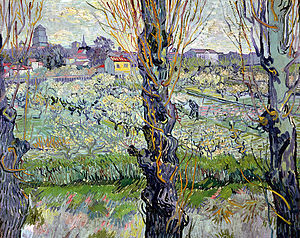| View of Arles, flowering orchards | |
|---|---|
| Original title, in French: Vue d'Arles, vergers en fleurs, Title in German: Blick auf Arles, blühende obstgärten | |
 | |
| Artist | Vincent van Gogh |
| Year | 1889 |
| Catalogue | |
| Medium | oil on canvas |
| Movement | Post Impressionism |
| Dimensions | 72 cm× 92 cm(28.3 in× 36.2 in) |
| Location | Neue Pinakothek, Munich |
View of Arles, Flowering Orchards is a painting by Vincent van Gogh, executed in spring 1889, one of several paintings he produced in his Flowering Orchards series while living in Arles.